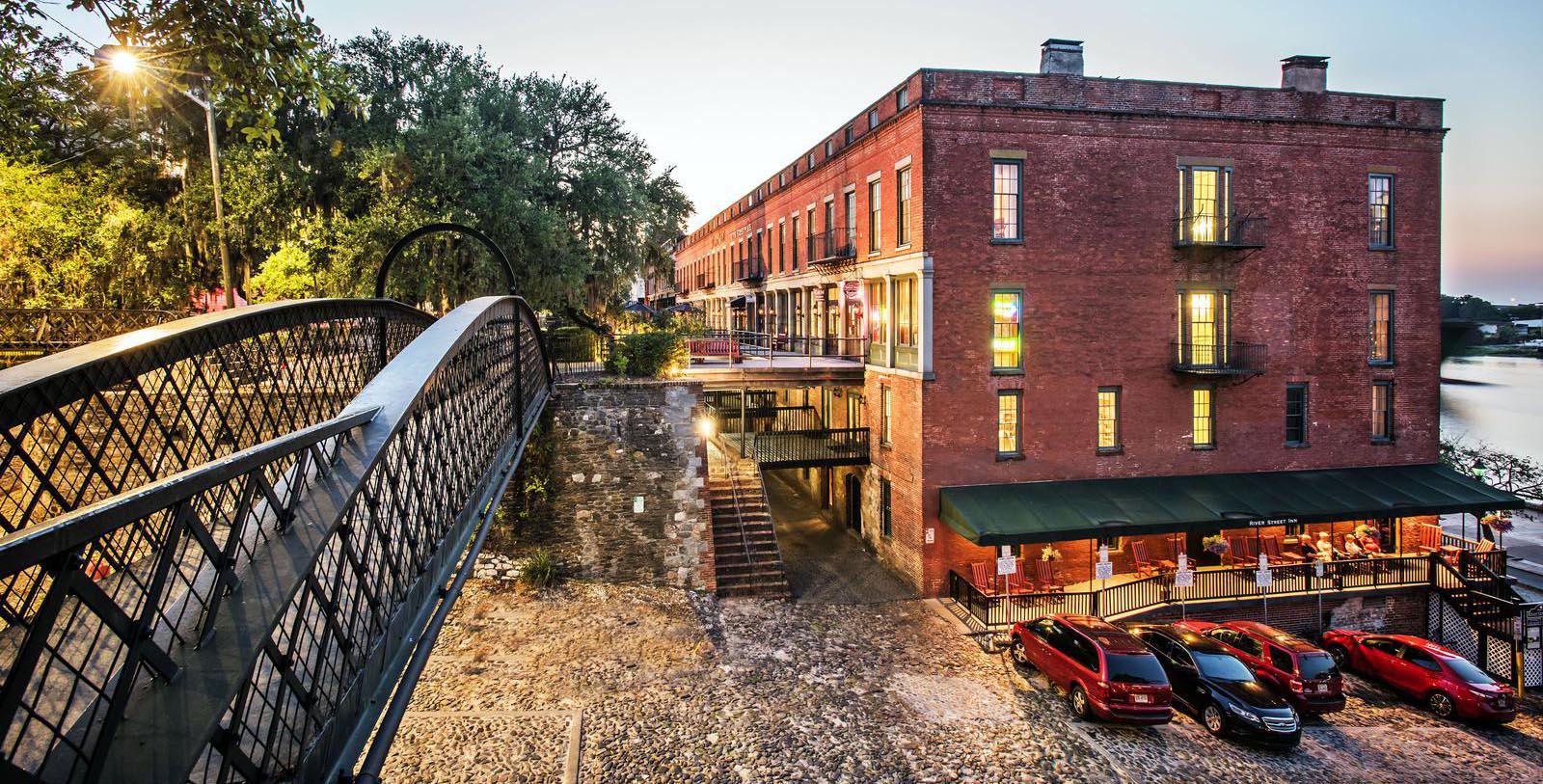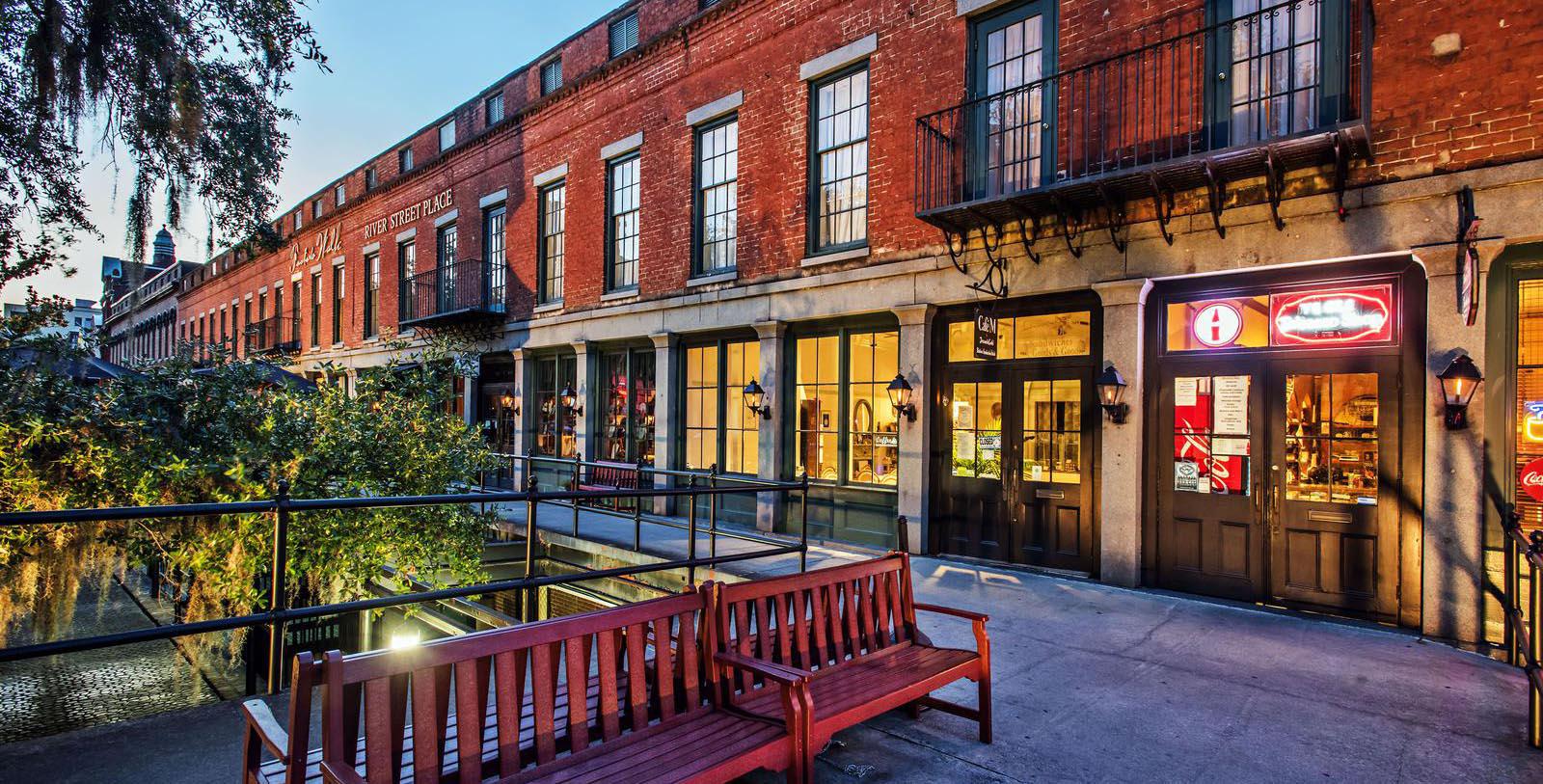Receive for Free - Discover & Explore eNewsletter monthly with advance notice of special offers, packages, and insider savings from 10% - 30% off Best Available Rates at selected hotels.
river street inn savannah history
Discover the River Street Inn with its rich industrial architectural heritage.
River Street Inn, a member of Historic Hotels of America since 1999, dates back to 1817.
VIEW TIMELINEA member of Historic Hotels of America since 1999, the River Street Inn has entertained countless guests since its grand opening a decade prior. Nevertheless, the inn’s history actually dates much farther back in time, specifically amid the growth of Savannah’s harbor in the early 1800s. While the city was already an established seaport at the start of the century, local merchants had begun exporting raw cotton from Savannah in large numbers. The activity subsequently infused significant quantities of new wealth throughout the community, prompting the construction of many new wharves and warehouses along Savannah’s coastline. Among the dozens of structures developed to help support the city’s growing cotton trade, local architects designed a number of interlocking, two-level storerooms next to the Cotton Exchange on River Street. Fascinatingly, the buildings possessed a unique architectural appearance thanks to the recycled ballast stone that the engineers used to manufacture their interiors. The stones were imported via the numerous ships that traveled to Savannah from Europe, and unloaded to make room for valuable cotton. (Among the warehouses constructed at the time included the future River Street Inn, which debuted in 1817.) Over time, the prosperity of the local cotton industry spurred the warehouse owners to further expand their buildings. In 1853, they specifically installed another three floors onto the structures, as well as an office space to supervise all of the cotton exports leaving the premises. An intricate series of alleys, walks, and bridges also appeared, giving traders access to all floors. Soon enough, the locals throughout Savannah began to refer to the line of warehouses as “Factor’s Walk” after the many professionals who graded—and eventually traded—the cotton stored inside.
Unfortunately, the city’s prosperous cotton industry gradually lost its economic momentum throughout the 20th century. In fact, in 1956, the last remaining warehouse along Factors Walk shut down, marking an end to River Street’s once bustling cotton export trade. Nevertheless, the entire area was protected as a historical landmark when nearly all its buildings were listed as part of the Savannah Historic District by the U.S. Department of the Interior a decade later. But true salvation for the area arrived when local entrepreneurs began various redevelopment projects along River Street that sought to transform the region into a mixed-use commercial neighborhood. Central to the project was the creation of a seven-million-dollar waterfront plaza that municipal business leaders planned to line with upscale storefronts and restaurants. During the ongoing construction efforts to revitalize the city’s coastline along River Street, several entrepreneurs decided to renovate one of the historic ballast-stone warehouses into a brilliant boutique hotel in 1986. Taking several months to complete, the new hotel was eventually christened as the “River Street Inn” when it made its debut a year later. The popularity of the River Street Inn proved to be so immense that ownership opted to expand the number of its available guestrooms in 1998. Building into a neighboring warehouse, the inn soon increased its total number of guestrooms to nearly 100. The River Street Inn has since continued to rank as among the best places to stay in all of historic Savannah. The surrounding buildings have experienced a new lease on life as shops, restaurants and taverns, each with their own special quality and the city’s famous squares are canopied by the towering moss-draped oaks and azaleas.
-
About the Location +
In 1733, a group of English colonists led by General James Oglethorpe departed from their ship, the Anne, and came ashore at a landmark called the “Yamacraw Bluff.” (The bluff is currently enclosed by downtown Savannah.) Upon making landfall, the settlers were greeted by the Chief Tomochichi and his fellow Yamacraw Indians. With the natives were John and Mary Musgrove, a couple of traders who often served as interpreters for the Yamacraw. The two camps quickly established friendly relations, and Oglethorpe began constructing a colonial outpost with the blessing of Tomochichi. The new town that Oglethorpe hoped to construct was to be the first official settlement for the new Georgia Colony, which he himself would govern. The general specifically intended for the community—and Georgia as a whole—to serve as a refuge for English subjects imprisoned for debt and other petty crimes. But the British Crown had an ulterior motive for granting Oglethorpe the right to create a colony in the “New World.”
Given its location at the southern end of British America, the royal government saw the nascent settlement as a buffer against any potential encroachments by either the Spanish or French against the more prosperous colonies to the north. Nevertheless, Oglethorpe—and his colleague, William Bull—began creating a town grid near the Yamacraw Bluff that loosely resembled London’s layout. Yet, the prospective community differed in that it featured more wards and central squares. Calling the settlement “Savannah,” it functioned as Georgia’s official capital for the next five decades. It also grew as a commercial port, second only to Charleston in its economic importance to those living in the southern colonies. Savannah’s vibrant harbor even made it a strategic target early on during the American Revolutionary War, with the British seizing the city in 1778. Despite the combined efforts of American and French soldiers to recapture Savannah, it remained in British hands for the duration of the conflict.
After the war in 1786, the Georgia legislature voted to move the capital several dozen miles away to Augusta. But Savannah continued to be one of the most commercially prosperous communities in the state, especially as its harbor continued to expand during the 19th century. Perhaps the epitome of such a transformation came when a steamboat called the “S.S. Savannah” sailed from the city to Liverpool in 1819, thus becoming the first steam-powered ship to cross the Atlantic. Most of the merchants who managed shipping operations out of Savannah mainly moved agricultural products, specifically cotton and other staple crops. Savannah then began operating as a major supply depot for the Confederate armies as soon as the American Civil War erupted, inspiring the U.S. Navy to immediately institute a blockade of its coastline. Northern soldiers succeeded in taking Fort Pulaski on nearby Cockspur Island in April of 1862 but failed to invade the city outright. Savannah continued to provide men and material defiantly for the next two years, until Major General William Tecumseh Sherman’s forces captured the city at the end of his historic “March to the Sea.”
Fortunately, the city recovered rather rapidly over the next several years, becoming a booming port once more by the late 1870s. Cotton returned as Savannah’s primary export, as did naval products like rosin, turpentine, and lumber. But when a prolonged boll weevil outbreak devastated the local agricultural industry in the 1920s, the shipping industry suffered greatly. Many Savannahians began looking to other industries, like food processing and paper-pulp manufacturing. The port eventually nonetheless recovered from the earlier blight, emerging as one of the nation’s most prolific shipbuilding locations by the middle of the century. In fact, Savannah produced dozens of liberty ships to support the national war effort in World War II. Savannah also became central to the Civil Rights Movement, with many non-violent protests occurring across the city. Among the first protests to transpire happened shortly after World War II, when Ralph Mark Gilbert directed a successful campaign to desegregate the local police force. Today, Savannah is celebrated all over the United States for its immense history.
-
About the Architecture +
The River Street Inn possesses a unique architectural style that can best be described as “eclectic.” Dating to the mid-19th and early 20th centuries, historians today consider “eclecticism” to be part of a much larger movement to fuse together a variety of historical designs. Earlier in the 1800s, architects—particularly those in Europe—decided to rely upon their own loose interpretations of historical architecture whenever they attempted to replicate it. Such a practice appeared within such styles as Gothic Revival, Italianate, and Second Empire architecture. But at the height of the Gilded Age, those architects wanted to use historic architecture more literally when developing a building. A few architects went a step further by combining certain historical styles together to achieve something uniquely beautiful. And in some cases, those individuals felt inspired to add a new historical form onto a building that they were renovating—just like the warehouse that would become the River Street Inn. Ultimately, the architects felt that joining such architectural forms together would give them a new avenue of expression that they otherwise did not have at the time. They also believed that they had stayed true to the earlier forms, so long as their designs perfectly replicated whatever it was they to mimicked.
In Europe, this approach first appeared as a rehash of Gothic Revival-style known as “Collegiate Gothic.” The European architects then used such a mentality to influence the unfolding philosophies of both the Beaux-Arts school of design, as well as the emerging Renaissance Revival-style. Many architects in America followed suit, the most notable of which being Richard Morris Hunt and Charles Follen McKim. The American architects who embraced “eclecticism” were at first interested in the country’s colonial architecture. Much of the desire to return to the time period was born from the revived interest in American culture brought on by the Centennial Exposition of 1876. Pride in preserving the nation’s heritage inspired the architects to perfect the design principles of their colonial forefathers in new and intriguing ways. This interest gradually splintered into other revival styles, though, like Spanish Colonial and Tudor Revival. Some Americans even infused the approach with the popular Beaux-Arts aesthetics of France, such as Hunt and McKim. Yet, the birth of Modernism in the 1920s and 1930s eventually ended the worldwide love affair with “eclecticism,” for architects throughout the West became more enchanted with the ideas of modernity, technology, and progress.































